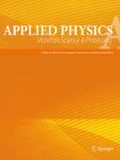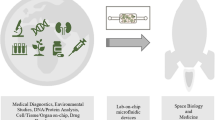Abstract
Lab-on-a-chip strategies using miniaturized devices enable cells to be cultured in a tridimensional (3D) space that offers a real model mimicking in vivo environment. One may provide architectural configurations relevant for specific tissues to maintain them at adequate temperature, oxygen levels, and pH during the necessary time intervals for observation. Herein, we propose a miniaturized lab-on-chip glass device suitable for simultaneous dosimetry measurements and evaluation of the biological effects of ionizing radiation on cancer cells. For the 3D fabrication of biologically relevant microenvironment, high repetition rate picosecond laser-assisted etching is applied to create microfluidic networks between sealed cell culture chambers in photo-sensitive glasses (PG). To evaluate the radiation dose, we employed collimated X-ray beams to generate free electrons in the PG samples by photoreduction of Ag ions to Ag atoms. A subsequent thermal treatment applied to the PG induced clustering of precipitated Ag atoms to color the exposed area to brown, which allows us to directly evaluate a threshold of the applied X-ray radiation dose applied directly on chip. Based on our glass biochip, we tested the response of human melanoma cancer cells exposed to various X-ray doses. This lab-on-chip platform is a valuable tool to analyze and validate the cellular response to new irradiation strategies as alternatives to conventional radiotherapy methods.







Similar content being viewed by others
References
R. Baskar, K.A. Lee, R. Yeo, K.-W. Yeoh, Int J Med Sci 9, 193 (2012)
R.-A.M. Panganiban, A.L. Snow, R.M. Day, Int. J. Mol. Sci. 14, 15931 (2013)
H. Gelband, P. Jha, R. Sankaranarayanan, et al., editors. Cancer: Disease Control Priorities, Third Edition (Volume 3). Washington (DC): The International Bank for Reconstruction and Development / The World Bank; 2015 Nov 1. Disease Control Priorities • Third Edition. Available from: https://www.ncbi.nlm.nih.gov/books/NBK343634/
B.F. Koontz, F. Verhaegen, D. De Ruysscher, BJR 90, 20160441 (2017)
D. Figeys, D. Pinto, Anal. Chem. 72, 330 (2000)
J. Castillo-León, W.E. Svendsen, Lab-on-a-chip devices and micro-total analysis systems (Springer, Cham, 2014)
N. Chaicharoenaudomrung, P. Kunhorm, P. Noisa, World J Stem Cells 11, 1065 (2019)
M. Chudy, K. Tokarska, E. Jastrzębska, M. Bułka, S. Drozdek, Ł Lamch, K.A. Wilk, Z. Brzózka, Biosens. Bioelectron. 101, 37 (2018)
F.E. Livingston, P.M. Adams, H. Helvajian, Appl. Surf. Sci. 247, 526 (2005)
T. Hongo, K. Sugioka, H. Niino, Y. Cheng, M. Masuda, I. Miyamoto, H. Takai, K. Midorikawa, J. Appl. Phys. 97, 063517 (2005)
M.H. Imanieh, B. Eftekhari Yekta, V. Marghussian, A. Aghaei, J. NonCrys. Sol. 354, 3752 (2008)
F. Jipa, S. Iosub, B. Calin, E. Axente, F. Sima, K. Sugioka, Nanomaterials 8, 583 (2018)
F. Jipa, S. Orobeti, C. Butnaru, M. Zamfirescu, E. Axente, F. Sima, K. Sugioka, Appl. Sci. 10, 8947 (2020)
C. Corbari, A. Champion, M. Gecevičius, M. Beresna, Y. Bellouard, P.G. Kazansky, Opt. Express 21, 3946 (2013)
S. Karimelahi, L. Abolghasemi, P.R. Herman, Appl. Phys. A 114, 91 (2014)
X. Li, J. Xu, A. Zhang, H. Peng, J. Zhang, Y. Li, M. Hu, Z. Lin, Y. Song, W. Chu, Z. Wang, Y. Cheng, Opt. Laser Technol. 144, 107413 (2021)
L. Orazi, V. Siciliani, R. Pelaccia, K. Oubellaouch, B. Reggiani, Procedia CIRP 110, 122 (2022)
A. Hendrickx, A. Cozzio, L. Plasswilm, C.M. Panje, Radiat Oncol 15, 174 (2020)
V.J. Thannickal, B.L. Fanburg, American Journal of Physiology-Lung Cellular and Molecular. Physiology 279, L1005 (2000)
J.L. Martindale, N.J. Holbrook, J. Cell. Physiol. 192, 1 (2002)
I. Porosnicu, C.M. Butnaru, I. Tiseanu, E. Stancu, C.V.A. Munteanu, B.I. Bita, O.G. Duliu, F. Sima, Molecules 26, 3403 (2021)
F. Sima, H. Kawano, A. Miyawaki, L. Kelemen, P. Ormos, D. Wu, J. Xu, K. Midorikawa, K. Sugioka, A.C.S. Appl, Bio Mater. 1, 1667 (2018)
P. Montay Gruel, B. Petit, F. Bochud, V. Favaudon, J. Bourhis, M.C. Vozenin, Radiother. Oncol. (2015). https://doi.org/10.1016/S0167-8140(15)40791-1
J. Bourhis, W.J. Sozzi, P.G. Jorge, O. Gaide, C. Bailat, F. Duclos, D. Patin, M. Ozsahin, F. Bochud, J.-F. Germond, R. Moeckli, M.-C. Vozenin, Radiother. Oncol. 139, 18 (2019)
C. DesRosiers, V. Moskvin, A.F. Bielajew, L. Papiez, Phys. Med. Biol. 45, 1781 (2000)
C.M. Desrosiers, Dissertation, An Evaluation of Very High Energy Electron Beams (up to 250 MeV) in Radiation Therapy (Purdue University, 2005) AAI3166611
Acknowledgements
This research was supported by IFA (Institute of Atomic Physics) through ELI-RO_2020_11 Project, No. 01/2020 and Romanian Ministry of Education and Research, under Romanian National Nucleus Program LAPLAS VI under Contract No. 16N/2019. This work has received funding from the European Union’s Horizon 2020 research and innovation program under Grant Agreement No. 871124 Laserlab-Europe.
Funding
The authors have no relevant financial or non-financial interests to disclose. This research received funding from IFA (Institute of Atomic Physics) through ELI-RO_2020_11 Project, No. 01/2020. This work has received funding from the European Union’s Horizon 2020 research and innovation program under Grant Agreement No. 871124 Laserlab-Europe.
Author information
Authors and Affiliations
Corresponding author
Ethics declarations
Conflict of interest
The authors have no competing interests to declare that are relevant to the content of this article.
Additional information
Publisher's Note
Springer Nature remains neutral with regard to jurisdictional claims in published maps and institutional affiliations.
Rights and permissions
Springer Nature or its licensor holds exclusive rights to this article under a publishing agreement with the author(s) or other rightsholder(s); author self-archiving of the accepted manuscript version of this article is solely governed by the terms of such publishing agreement and applicable law.
About this article
Cite this article
Staicu, C.E., Jipa, F., Porosnicu, I. et al. Glass lab-on-a-chip platform fabricated by picosecond laser for testing tumor cells exposed to X-ray radiation. Appl. Phys. A 128, 770 (2022). https://doi.org/10.1007/s00339-022-05915-0
Received:
Accepted:
Published:
DOI: https://doi.org/10.1007/s00339-022-05915-0




